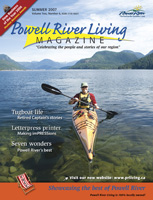Summer 2007
Table of Contents
In this Issue
Tugboat life creates coastal memories
Four fabulous Powell River adventures
What to do in Powell River
Beyond Lund to Savary
Turn off the computer; go fishing
Where to stay in Powell River
Mobile sailing school coming
Best ice cream
Seven wonders of Powell River
Where to eat in Powell River
Letterpress printer makes an imPRESSion
PR Living launches website
Car buffs show off vehicles
Let's go camping!
Going Green
Water: a disappearing resource
Summer tides
The art of the opening
Unique carvings on restaurant
Pretty as a peacock
Seniors growing in numbers
The business of golf
Tourism challenges and payoffs
Summer on Powell Lake
The Outsider
Growing wild in Powell River
Soccer stars go to Brazil for Paralympics
Fairs, festivals and events
Map of Powell River
In every Issue
Family Matters
Blast from the Past
Company town's champoin pipe band
Explore Powell River
In Business
From Brizzy Vegas to Lund
Business Connections
Bookends
Community Calendar
Faces of Education
 Connect with nature this summer
Connect with nature this summer
Hiking through the woods. Watching a fiery red ball dip below the horizon. Listening to waves lapping against the shore. Staring into the dancing flames of a campfire. Waiting patiently until just the right moment to catch a frog. Lying on your back in a field of wildflowers and watching fluffy white clouds scuttle across a deep blue sky. Finding a nest of wood bugs crawling beneath a rotting log. Delighting in the sight of an unexpected plant along a forest path. Bathing in an icy mountain stream. Catching your first fish. Waking to the call of a loon on a still summer morning. Learning what the j-stroke is. Doing something you’ve never done before.
Many of my summer memories are connected to times we spent camping as a family and the summer camps I attended. I remember camping at Kejimkujik National Park, emerging from the water covered in leaches. My parents thought I was mortally wounded—and I was, in my own mind—but once the leaches were removed, I lived. I’ll never forget the time I gathered old cow’s teeth from a meadow and tucked them under my pillow because I hoped to trick the tooth fairy into leaving me money.
I remember how our old aluminum canoe slipped silently across the water as it took me places that no one else had been before. I remember falling in love with Diamond Judy, a grey pony that taught me all about jumping.
Summer is about listening to crickets and taking time to make memories. It’s about making lemonade from fresh lemons, it’s about being with your kids, taking a break from the regular routine and slowing down long enough to think about the meaning of life.
I always feel centered after spending time in the great outdoors. There’s something about trees, the smell of damp moss or the salt of the ocean that I find soothing.
For many of us there is an increasingly direct absence of nature in our lives. It has happened over the years without us even noticing.
When you talk to old timers about their childhood, they’re likely to tell you that they spent any spare time after finishing chores playing outdoors with their friends. They went fishing, hunting and scoured the woods.
In the last 50 years we have become more and more dependant on electronic stimulation for our own entertainment. Look at how paved parking lots and super malls have taken over what once were forests. Where has nature gone?
I remember feeling washed in peace when I walked by what used to be a large tract of towering trees at the top end of Joyce Avenue just past the hospital. Every time I went by this spot, I felt like a giant hand was lifting my worries away.
Camping and summer camps like the school district is offering up at Rainbow Lodge are vitally important to the future of our children and society. As poet William Wordsworth says, “Let nature be your teacher.” Open your eyes and look at the wonderful world around us. We can all learn so much by opening our eyes to God’s creation. When we turn off our cell phones and computers and lace up a pair of hiking boots, our body and soul benefit. After all, kids who spend their days racing up and down trails, swimming and paddling are doing what kids are meant to do—being kids.Tugboat life creates coastal memories
By Devon Hanley Southcott
Living on Powell River’s Westview slope there’s never a moment when you can’t look up and see a tug working its way north or south along the Malaspina Strait. Tugs towing behemoth barges, headed for the mill to dump their papermaking load before turning south, or a mosaic of logs gliding like a carpet behind a thrumming engine. At night, lights move slowly against black water; two or three stacked like stars on the tug’s mast and not too far behind, twinkling blue pinpoints like distant planets warn a boom is in tow.
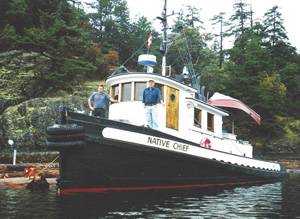 In the winter months, tugs and their unwieldy booms seek the shelter of Grief Point, tying up to buoys while they wait out the southeasters. Rain hammers my small, west-facing house and I watch, wondering how the captain and crew pass their time, how many steaming mugs of coffee, heated up meals, radio calls and long naps until they can move back out into the Strait.
In the winter months, tugs and their unwieldy booms seek the shelter of Grief Point, tying up to buoys while they wait out the southeasters. Rain hammers my small, west-facing house and I watch, wondering how the captain and crew pass their time, how many steaming mugs of coffee, heated up meals, radio calls and long naps until they can move back out into the Strait.
When I realized one of my neighbors was the recently retired captain of Native Chief, a beautiful classic wooden tug, I jumped at the opportunity to find out more about tugs and the people who work them. Here was a chance to talk to someone who had made a living out on the water. And this was not just any tugboat captain, but one with a significant connection to the history of this region, Gary Thulin.
It was Gary’s grandfather Fred Thulin, and his grandfather’s brother, Charles Thulin, who founded the towns of Lund and Campbell River. Tired of farm work in the wet and cold of his native Sweden, sixteen year-old Fred followed his brother Charlie to Canada, arriving in Vancouver in February of 1889.
Fred located his brother up the coast, and joined him in Pendrell Sound where the two hand-logged over the summer. In December the brothers moved to a site just south of the Copeland Islands which they christened Lund the following year. Lund was the name of a university in Sweden, but most importantly, according to Fred, it was easy to spell and easy to remember.
Fred and Charles set to work—first they built a wharf, then a pipe to carry water to the wharf in order to supply tugs with water and wood for fuel. Next they cleared land for farming, hauling cord wood to the dock on a wooden sled drawn by a pair of bulls. In 1892 the brothers established a post office, the second to be established north of Vancouver, followed by a small store, and in 1894, a hotel.
In addition to building and running the post office, store and hotel, Fred and Charlie continued logging, first with oxen, and then in 1905 with a donkey engine. They also built four steamers (tugs), as well as several scows and gas boats. In 1904 the brothers moved to Campbell River and established a hotel which was subsequently operated by Charles. Fred returned to Lund and assumed the duties of postmaster and Justice of the Peace.
Fred Thulin married twice, producing six boys and one girl. Upon his death in 1935, Gerald and Holger, two sons from Fred’s second marriage to Finnish wife Ida Emelia, took over the running of Lund. Gerald ran the hotel, the fuel dock and the store. He married Ruby Johnson from Saskatoon and had two sons, Gary and Bryan.
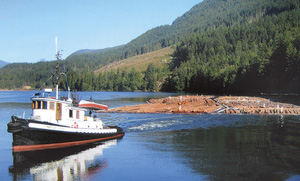 “Life in Lund revolved around the water,” recalls Gary. “My brother and I were running boats by the time we were six years old, starting out with outboards and fish boats.” As they got older, the brothers helped out on the fuel dock and worked salvaging logs. In his teens, Gary spent some time working on the log booms, further honing the skills he would later call into use as a tugboat captain in the sorting grounds of Jervis Inlet.
“Life in Lund revolved around the water,” recalls Gary. “My brother and I were running boats by the time we were six years old, starting out with outboards and fish boats.” As they got older, the brothers helped out on the fuel dock and worked salvaging logs. In his teens, Gary spent some time working on the log booms, further honing the skills he would later call into use as a tugboat captain in the sorting grounds of Jervis Inlet.
In the early 60s Gary moved from Lund to Powell River, and soon found work sorting logs in Vanguard Bay. It was this job which gave him the opportunity to go into business for himself. “They needed a little tug to work the sorting grounds,” explains Gary, “So I bought Sea Bark, a 36-foot, single engine wooden tug.”
It was about this time Gary began working exclusively for the Vancouver firm, Pacific Towing Services, sorting logs from Crown Zellerbach Canada’s log barges coming into Vanguard Bay, and then Goliath Bay. “I always liked working on the water, and I liked being in business for myself,” says Gary. His brother, Bryan, served as alternate skipper between 1972 and 1985, as the two worked 5-day rotations along with two crew-members.
The downturn of BC’s forest industry in the early 90s saw several sorting grounds shut down. “In ’94 we started working the outside with Native Chief,” says Gary. Built in 1955 by North Vancouver’s Bisset & Gilstein, Native Chief measures 46 feet and 20 gross tons, a tug well suited to towing barges and booms in the less protected waters of the Strait of Georgia.
Outside towing means days away from home, and working with the weather. “Weather’s always a factor,” smiles Gary. “You are always listening and making your moves accordingly.” Gary provides the following description of the log tower’s lot—hours of boredom and moments of sheer terror! He acknowledges being caught in the wind a few times, but was lucky to never have had any major log spills.
From the early 90s until retirement last August, Gary worked mainly for Coastland Wood Industries and Doman Forest Products, towing from Powell River to Nanaimo, and also for Merrill and Ring, a company logging in Theodosia Inlet. “Specialty towing is what it was,” reminisces Gary. “There are still a few smaller companies around with four or five tugs working certain areas, but we saw the best of it.”
Gary relates a story from his towing days. “We were towing boomsticks (66-foot logs used to make log booms) from Vanguard Bay down to Earl’s Creek. We were approximately halfway between Saltery Bay and Earl’s Cove, in an area known as Whiskey-November when I got a call asking us to shut off our engine. I told them I was working and wanted to continue. They explained they were going to be firing a 30-foot motion-seeking torpedo, so I agreed to wait until they were done.”
Both Gary’s sons, Rick and Scott, worked with him for a time. “Scott worked on the Native Chief for five years and he’s still working on the tugs doing outside towing,” reports Gary. Meanwhile, Native Chief, now moored in Powell River’s Westview harbour, is waiting for a new captain to put her to work.
These days Gary enjoys keeping an eye on all the marine traffic from the comfort of his sun-washed west-facing deck. Jeanette, Gary’s wife, says there isn’t a tug he can’t identify. “Gary knows all the captains, knows their boats,” chuckles Jeanette. She concedes life is a little more predictable these days. Being a tug boat captain’s wife meant not waiting dinner, and often going ahead with social plans solo. “The weather didn’t always cooperate,” Jeanette recalls. “Sometimes they’d be waiting it out, tied up somewhere for a day or two.” Now it’s Gary and Jeanette’s turn to watch the tugs go by, and if the weather turns, well, no matter—it’s warm and cozy inside.
One letter at a time
Letterpress printer makes an imPRESSion
By Isabelle Southcott
Most of us don’t give a lot of thought about what was involved to print a flyer, poster or book hundreds of years ago. Today, all you have to do is hit the print key on your computer and viola, out comes a page.
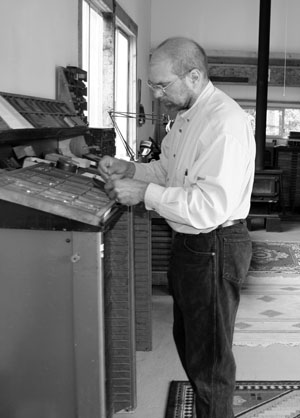 Before computers, letterpress printing was used for printing text with movable type. The raised surface of the type is inked and pressed against a smooth substance to obtain an image in reverse.
Before computers, letterpress printing was used for printing text with movable type. The raised surface of the type is inked and pressed against a smooth substance to obtain an image in reverse.
Letterpresses are large and heavy. They aren’t the sort of thing you’ll find in most people’s homes, but Stuart Istos isn’t most people. His studio on Cranberry Lake is home to several letterpresses that he uses to print limited edition books and cards.
Letterpress printing is a hobby for Istos who moved to Powell River with his wife Liz Horsfield two years ago. “Up until the 20th century all books were done on letterpress,” he says. “Then there was an evolution of a few stages. The major transition was to offset printing which is still pretty dominant today.”
Istos, who is a deacon at the Anglican Church, has always been interested in books. He became interested in letterpress printing through the Alcuin Society, a book arts society that includes binding and printing and papermaking. “I’m trying to create something that is unique. Books produced by letterpress are limited edition books.”
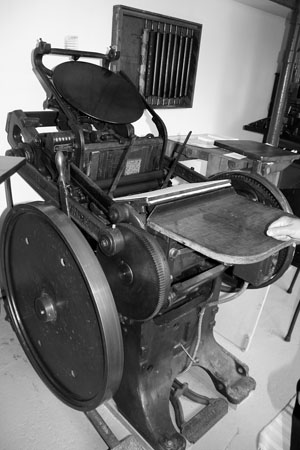 Letterpresses excel at printing upscale invitations, stationery and fine editions of books. The process, which often requires the press operator to feed paper one sheet at a time, requires a high degree of craftsmanship.
Letterpresses excel at printing upscale invitations, stationery and fine editions of books. The process, which often requires the press operator to feed paper one sheet at a time, requires a high degree of craftsmanship.
Istos bought his first letterpress in 1988. He purchased a Chandlar and Price from a glassblower in Mission, BC. Before that, the press had belonged to a reform school and in the 30s, 40s and 50s it was used for teaching students.
The letterpress was moved to Istos’ basement in the lower mainland and he began printing personalized stationary, keepsakes and Christmas cards on it. “The object of printing, from my perspective, is to create books. There is really nothing else to print of any significance.”
One press led to another and then another. It was cramped in the basement and Istos began dreaming of the day when he’d have more room.
Istos has five presses now. “I collected them over the years. We just got one from Saltspring Island from a poet and hobby printer who is moving to Savary.”
It is obvious that Istos is attached to his presses. They weight over a ton each. “This one came from Chicago,” he says. “Our basement in Vancouver was wall to wall presses—there was no room.”
Istos and his wife wanted to move out of Vancouver. “We came here kayaking three times and Powell River was the best community we found.”
Istos worked in information technology before moving to Powell River. He says letterpresses and information technology aren’t so far apart, really.
You feel like you’ve stepped back in time when you enter his studio. The smell of a special solvent permeates the air above the polished wood and shiny plates of the presses. The Ostrander Seymour press is the oldest in his collection. “It’s an iron hand press,” he explains. There’s an electric press made by Chandlar and Price around 1925 and a treadle press from 1905.
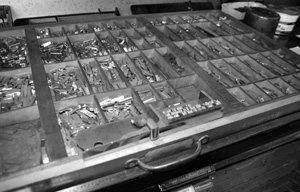 “Every word counts,” he says, explaining how he uses a composing stick to set type, one letter at a time.
“Every word counts,” he says, explaining how he uses a composing stick to set type, one letter at a time.
These days Istos is printing Conversations With The Devil By Franz Werfel. “It’s never been translated into English before,” he explained. “It was written in the early 1900s.”
Before he can even begin the laborious task of printing, he has to make sure he has all the letters he needs. “You’re always running out of letters,” he observes.
Once the printed word or image is down on paper, Istos then binds it as a book.
“They used to sell books without cutting the pages so people would know that no one else had read them. If you collect books you will find some with uncut pages.”
Istos is part of this summer’s art tour. He’d also like to offer tours to schoolchildren to introduce them to what came before the computer. “I’d like to show them that this is step one, this is step two, this is step three, that you don’t just push a button and say print.”
Seven Wonders of Powell River
Those of you who listened to CBC Radio know all about the seven wonders of Canada and how much fun people across our great country had in coming up with and defending their pick of Canadian wonders. We thought it would be fun to short list Seven Wonders of Powell River, and hope you will send us your choices so we can create a new list for next summer.
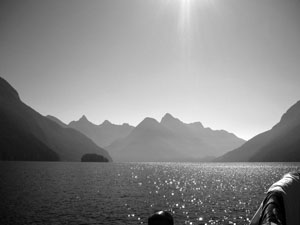 1. Powell Lake & Powell River Although one is a lake and one is a river, we figured it only counts as one because the river runs into the lake. Powell River is the third shortest river in the world and the oldest trapped seawater yet to be discovered is in the deepest part of Powell Lake.
1. Powell Lake & Powell River Although one is a lake and one is a river, we figured it only counts as one because the river runs into the lake. Powell River is the third shortest river in the world and the oldest trapped seawater yet to be discovered is in the deepest part of Powell Lake.
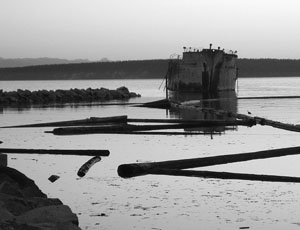 2. The Hulks This floating breakwater of concrete ships is the longest floating breakwater in the world. Currently there are 10 concrete ships, nine of which are Second World War vintage and one, the Peralta, a tanker built for the First World Ward, has been afloat for 87 years.
2. The Hulks This floating breakwater of concrete ships is the longest floating breakwater in the world. Currently there are 10 concrete ships, nine of which are Second World War vintage and one, the Peralta, a tanker built for the First World Ward, has been afloat for 87 years.
3. Magnetic Hill at Gibson’s Beach has the distinction of having one of Canada’s few naturally occurring magnetic hills. The magnetic hill is north of the city of Powell River along the road that leads to Gibson’s Beach.
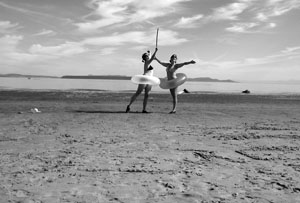 4. Beaches Powell River’s fabulous beaches are second to none. From the sandy white shores of subtropical South Beach and others on Savary Island, to Donkersley Beach and Palm Beach in the Regional District, to Shelter Point Park Beach on Texada Island, our beaches are brilliant for swimmers, kayakers and beach combers. Don’t forget your hat and sunscreen!
4. Beaches Powell River’s fabulous beaches are second to none. From the sandy white shores of subtropical South Beach and others on Savary Island, to Donkersley Beach and Palm Beach in the Regional District, to Shelter Point Park Beach on Texada Island, our beaches are brilliant for swimmers, kayakers and beach combers. Don’t forget your hat and sunscreen!
 5. Sliammon Legends The Sliammon people had no written language and therefore stories of tribal origin, history, achievements and newly learned facts had to be passed on verbally from one generation to the next through myths and legends. Storytelling was an essential part of their cultural heritage. Gathered around the lodge fires during the long winter evenings, children listened to myths and legends reaching way back into Sliammon history and the young minds became the storage source for all the passed on knowledge. Myths and legends also formed the basis for the ceremonial songs, and spirit dances took place inside longhouses when the people gathered together for the winter ceremonies.
5. Sliammon Legends The Sliammon people had no written language and therefore stories of tribal origin, history, achievements and newly learned facts had to be passed on verbally from one generation to the next through myths and legends. Storytelling was an essential part of their cultural heritage. Gathered around the lodge fires during the long winter evenings, children listened to myths and legends reaching way back into Sliammon history and the young minds became the storage source for all the passed on knowledge. Myths and legends also formed the basis for the ceremonial songs, and spirit dances took place inside longhouses when the people gathered together for the winter ceremonies.
6. Fishing in the Eldred Valley The Eldred Valley is a fabulous place to fish. It has some of the largest cutthroat in all of Canada so bring your fishing rod and prepare for a great day of fishing.
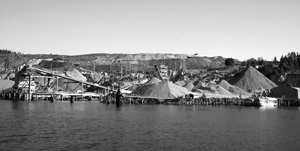 7. Texada Island Just a 20-minute ferry ride away from Powell River is Texada Island. Named in 1791 by Spanish explorers, Texada is known for its wealth of minerals, its unique plants and animals including painted turtles, salamanders and the great frog migration that occurs every summer. Van Anda became a boom town after iron ore and later copper and gold was discovered in the late 1800s and Van Anda boasted the only opera house north of San Francisco, three hotels including the Bucket of Blood Saloon, a hospital, an illegal distillery and many stores and businesses. Texada is still home to three working limestone quarries, shipping out more than six million tons of limestone annually.
7. Texada Island Just a 20-minute ferry ride away from Powell River is Texada Island. Named in 1791 by Spanish explorers, Texada is known for its wealth of minerals, its unique plants and animals including painted turtles, salamanders and the great frog migration that occurs every summer. Van Anda became a boom town after iron ore and later copper and gold was discovered in the late 1800s and Van Anda boasted the only opera house north of San Francisco, three hotels including the Bucket of Blood Saloon, a hospital, an illegal distillery and many stores and businesses. Texada is still home to three working limestone quarries, shipping out more than six million tons of limestone annually.
Do you have another Powell River wonder that should appear on this list? Send it to us at publisher@prliving.ca and tell us why your wonder is so special!
From Brizzy Vegas to Lund:
Lovebirds trade Down Under for Top of the World
By Isabelle Southcott
Queenie’s friends at Style Magazine in Brisbane, Australia thought she was nuts when she told them she was quitting her job as an account executive to open a restaurant in the small coastal community of Lund, British Columbia with her new partner.
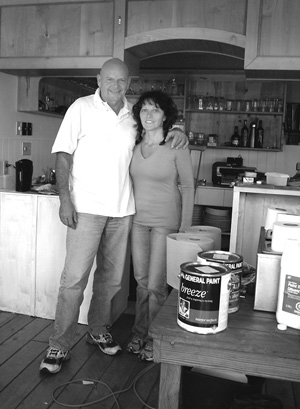 Catherine Burton, (Queenie) had never laid eyes on Canada, let alone Lund until she and her partner of a mere 35 weeks, Ian Thomason, landed here on May 23.
Catherine Burton, (Queenie) had never laid eyes on Canada, let alone Lund until she and her partner of a mere 35 weeks, Ian Thomason, landed here on May 23.
Ian, on the other hand had been to Canada several times since his first trip in 1983. “I just loved BC so much that I had been saying to people if I ever lived anywhere else in the world it would be in BC,” the former realtor told Powell River Living Magazine.
Ian’s close Canadian friends who live in Edmonton were kayaking in Lund last year when they saw the restaurant at the end of the boardwalk was for sale. “They took a photo and emailed it to me.”
The photo, taken at high tide, made everything look absolutely brilliant. “It was one of those photos that I couldn’t get out of my mind,” Ian said.
Ian was at a time in life when he was feeling restless and every time he’d go by his computer he’d sneak a look at the photo.
Although he had no previous experience in the hospitality industry, he’d always been interested in it. “Here was a place I’d like to live with a business I was interested in. There was an attraction,” he admits.
The restaurant in Canada wasn’t the only attraction that was happening in Ian’s life. He’d recently met Catherine and the two had fallen in love.
“I met Ian and that was it,” says Catherine.
Her life did a complete backflip and all of a sudden she found herself resigning from the job she loved so much.
“We started talking about living somewhere else in the world at the beginning of January and we made a pact that by June 30 we’d live somewhere else outside of Australia,” says Ian. “We looked at options—the Middle East would have been fantastic financially but it wasn’t the lifestyle we wanted. I pulled out the photo of the restaurant in Lund and showed it to Catherine.”
Ian and Catherine continued to talk about what they wanted to do. In the meantime they took a ski holiday in Japan. “I looked out of the window of the train and felt so sorry for the people living in the small villages, and then I thought about myself and realized that I was no different.”
Catherine was getting a bit fed up with Ian’s indecisiveness so she told him he needed to do one of two things. “I said, ‘either you jump on a plane and go to Canada and look at this place or shut up.’”
Two days later Ian was on his way Lund. He arrived in early March, looked around, met the locals and investigated the restaurant for sale. He made an offer through Janet Alred at Westview Realty before heading back to Australia.
It took a while to agree on price but they finally did. Friends and relatives didn’t believe them at first and were sure they’d change their mind when Ian broke his leg after a “little incident” on his Harley. When they realized how serious they were they thought their adventure should be recorded. “We brought a TV crew with us,” laughed Catherine. “Channel 7, a national TV channel in Australia, does a show called The Real Sea Change and they’ve been filming us.”
The couple was filmed several times before they even left Australia right up to their farewell party, leaving the airport and arriving in Vancouver. The Real Sea Change crew then followed them to Lund where they caught Catherine’s first impressions on camera.
Catherine and Ian are staying in a trailer at SunLund RV Park until they finish renovating the apartment above their new restaurant which they have called “The Boardwalk” because it is at the end of the boardwalk in Lund, naturally.
They gutted the inside of the restaurant and are having a ball putting it back together. “We had to throw out pretty much everything that was here,” said Ian pointing out it had been closed for nearly two years.
“It has been fun,” says Catherine. “We did it and here we are. We’re staying sane by nurturing each other and using our sense of humour to get us through.”
It is difficult to envision Catherine dressed to the nines in high heels and makeup. With her torn blue jeans, layered T-shirt and pigtails, she looks like the hard-working entrepreneur that she is but when she turns and walks away, she has this style, a certain style that is hard to describe.
So when she expressed concern that she had nowhere to wear her fancy dresses, Ian promised to take her somewhere nice. “I’ll take you to the restaurant at the Lund Hotel for dinner.”Rainbow Lodge: experiential learning opportunities
Rainbow Lodge has a new focus these days.
Instead of being a destination to entertain corporate customers from the mill, Rainbow Lodge is well on its way to becoming a leadership learning and team-building centre.
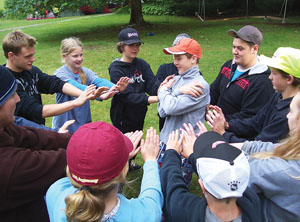 School District 47 has leased the lodge and is running a variety of programs, camps and workshops out of the lodge this summer and in the months that follow.
School District 47 has leased the lodge and is running a variety of programs, camps and workshops out of the lodge this summer and in the months that follow.
It’s an exciting time for Ryan Barfoot and his wife Karin Westland who are running the camps. Both Barfoot and Westland have education degrees with a specialty in outdoor education and experiential learning. Barfoot positively beams when asked what’s going on up at Rainbow these days.
Just a 40-minute boat ride up the lake in a remote wilderness setting, Rainbow Lodge is tucked into a private bay behind Goat Island.
During June, most of the grade seven classes in the district spent two days up at Rainbow for an end-of-the-year camp. Not only were these camps fun for the grade sevens but they also provided students involved in this year’s BOATT program (Brooks Outdoor Adventure Tourism Training) with the opportunity to showcase the skills they learned during the year in a real-life setting.
“It’s so amazing from my perspective seeing my students taking that forward, taking the lead, taking that leap of faith from being trained with a skill to actually doing it,” said Barfoot.
Not only is this rewarding for Barfoot who oversees the camp but it is also a real achievement for BOATT program students as they basically run the camps. “This kind of program is invaluable from an educational point of view.”
Another element of having BOATT program students run end-of-year camps that has Barfoot excited is the mentoring that’s going on between grade sevens and high school students.
“BOATT program students are actively accepting leadership responsibilities and applying them in the form of mentorship. We have responsible secondary students mentoring grade seven students who are at a time in their lives when they’re looking for positive role models.”
Although Barfoot definitely isn’t old and doesn’t look nerdy, he said mentorship works because his students can relate to the younger students in ways that as adults, we can’t. “They will always be cooler than me! This is an ancient way of educating and I know I have done my job when I see the mentorship process in effect.”
Barfoot’s work at Rainbow Lodge revolves around environmental values, ethics and teamwork. One way they teach the grade seven students to work as a team during their two-day retreat is by doing a low ropes course. “This is a team-building initiative that allows students to work with each other in a way that a classroom does not. It instills the important aspects of team and community.”
Barfoot and Westland are excited about two summer camps they are running at Rainbow Lodge that are free to students. Two LEAP (Leadership Ecology Adventure Program) camps are offered by the district. The first camp this summer, from July 3 to 6, is for grade six students. “It focuses on sustainability, ecology, leadership and adventure,” said Barfoot. “It’s about students having fun exploring the natural world around them.”
Barfoot is passionate about his job and the school district’s vision for new programs and opportunities. “Today’s leaders needs to focus on sustainability. The biggest challenge that students will have in the future will be how to meet community needs without depleting the planet’s diversity.”
Barfoot’s first summer job, while he was in high school, was working at a summer camp. Both Barfoot and Westland have worked internationally and for non-profit organizations developing and delivering programs. “We came to Powell River because we recognized there was not only a need for this kind of learning but a huge opportunity here,” said Barfoot.
The second camp this summer, from July 9 to 17, is a four credit course for high school students. They’ll experience canoeing, hiking, camping, rock climbing, scuba diving, leadership and ecological studies free of charge. “Students will be supervised by certified teachers and professional outdoor educators,” said Barfoot.
“This is an exciting opportunity for students who love to be active and are interested in improving their leadership skills as well as their understanding of local marine and terrestrial ecology. LEAP is an outdoor and experiential camp that focuses on both the hard and soft skills associated with living in and educating in the outdoors,” said Barfoot.
Although the camp is based out of Rainbow Lodge, not all the activities take place at the lodge.
Students travel as a cohort group, have a diverse experience and sample different outdoor activities. “The thread that bonds them is ecological studies and sustainable studies,” said Barfoot. “We are exploring our ecosystem. We embrace a diversion to look at.”
In the end it all comes down to learning by doing. Learning strong leadership skills, active problem solving skills and understanding the importance of community.
For more information on opportunities at Rainbow Lodge, please contact Jim Palm at 604 414-5960 or jpalm@sd47.bc.ca.
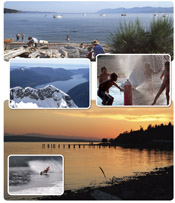
Photos about our wonderful region...
